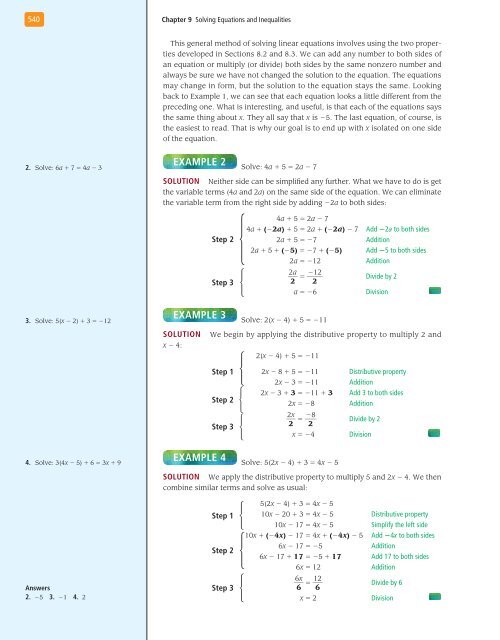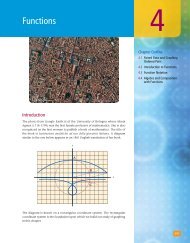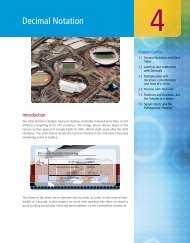Chapter 9 - XYZ Custom Plus
Chapter 9 - XYZ Custom Plus
Chapter 9 - XYZ Custom Plus
You also want an ePaper? Increase the reach of your titles
YUMPU automatically turns print PDFs into web optimized ePapers that Google loves.
540<br />
<strong>Chapter</strong> 9 Solving Equations and Inequalities<br />
This general method of solving linear equations involves using the two properties<br />
developed in Sections 8.2 and 8.3. We can add any number to both sides of<br />
an equation or multiply (or divide) both sides by the same nonzero number and<br />
always be sure we have not changed the solution to the equation. The equations<br />
may change in form, but the solution to the equation stays the same. Looking<br />
back to Example 1, we can see that each equation looks a little different from the<br />
preceding one. What is interesting, and useful, is that each of the equations says<br />
the same thing about x. They all say that x is 25. The last equation, of course, is<br />
the easiest to read. That is why our goal is to end up with x isolated on one side<br />
of the equation.<br />
2. Solve: 6a 1 7 5 4a 2 3<br />
Example 2<br />
Solve: 4a 1 5 5 2a 2 7<br />
Solution Neither side can be simplified any further. What we have to do is get<br />
the variable terms (4a and 2a) on the same side of the equation. We can eliminate<br />
the variable term from the right side by adding 22a to both sides:<br />
4a 1 5 5 2a 2 7<br />
54a 1 (−2a) 1 5 5 2a 1 (−2a) 2 7 Add 22a to both sides<br />
Step 2 2a 1 5 5 27 Addition<br />
2a 1 5 1 (−5) 5 27 1 (−5) Add 25 to both sides<br />
2a 5 212<br />
Addition<br />
Step 3<br />
5<br />
} 2 a<br />
} 5 } 2 12 } Divide by 2<br />
2 2<br />
a 5 26<br />
Division<br />
3. Solve: 5(x 2 2) 1 3 5 212<br />
Example 3<br />
Solve: 2(x 2 4) 1 5 5 211<br />
Solution<br />
x 2 4:<br />
We begin by applying the distributive property to multiply 2 and<br />
Step 1<br />
Step 2<br />
Step 3<br />
5<br />
5<br />
5<br />
2(x 2 4) 1 5 5 211<br />
2x 2 8 1 5 5 211<br />
2x 2 3 5 211<br />
2x 2 3 1 3 5 211 1 3<br />
2x 5 28<br />
Distributive property<br />
Addition<br />
Add 3 to both sides<br />
Addition<br />
} 2 x<br />
} 5 } 2 8<br />
} Divide by 2<br />
2 2<br />
x 5 24<br />
Division<br />
4. Solve: 3(4x 2 5) 1 6 5 3x 1 9<br />
Answers<br />
2. 25 3. 21 4. 2<br />
Example 4<br />
Solve: 5(2x 2 4) 1 3 5 4x 2 5<br />
Solution<br />
We apply the distributive property to multiply 5 and 2x 2 4. We then<br />
combine similar terms and solve as usual:<br />
Step 1<br />
Step 2<br />
Step 3<br />
5<br />
5(2x 2 4) 1 3 5 4x 2 5<br />
10x 2 20 1 3 5 4x 2 5<br />
10x 2 17 5 4x 2 5<br />
10x 1 (−4x) 2 17 5 4x 1 (−4x) 2 5<br />
5<br />
6x 2 17 5 25<br />
6x 2 17 1 17 5 25 1 17<br />
6x 5 12<br />
5<br />
Distributive property<br />
Simplify the left side<br />
Add 24x to both sides<br />
Addition<br />
Add 17 to both sides<br />
Addition<br />
} 6 x<br />
} 5 } 1 2<br />
} Divide by 6<br />
6 6<br />
x 5 2<br />
Division

















